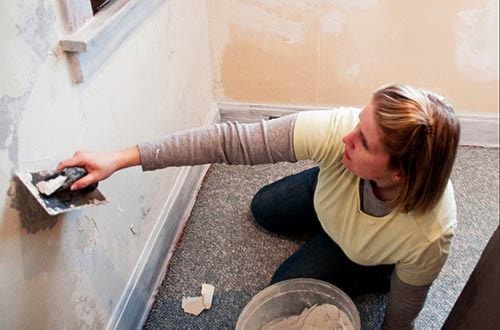Interior design professionals frequently say that the fastest and cheapest way to make a major change to a room’s look is to give boring white walls a facelift.
And while painting a room in a bold new colour is the obvious way to make that change, new designs and techniques go a little further with drywall, faux painting, and nontraditional wall coverings.
“Everybody has different visions, depending on where they have searched online,” says Naz Merali, owner-operator of Maple Ridge Paint and Deco. “It all depends on what a person is looking to do.”
The paint and wall-covering specialist says there is a trend in colour changes on a homes’ feature walls.
“There’s a modern trend right now in something called ‘greige,’ which is a gray-beige kind of colour. The homes of the ’70s, ’80s and ’90s had a lot of earth and tan colours. They are now flipping over and going to ‘greige,’ which is, like I said, very light grays and very light tan colours to make it more modern — with a lot of white trim.”
Merali says people are also interested in metallic finishes.
“This is something that happened a few years ago, but they’ve started looking at that again,” he explains. “You can get metallic paints and you do it in a small area, not on a big wall because it becomes quite overpowering when you do it on a big feature wall.”
He also says faux painting is popular these days for people looking to shake up their home’s appearance.
Faux painting, which uses decorative and special paint finishes, is a popular way to change your home’s appearance. Faux painting produces finishes that resemble wallpaper through the use of glazing, sponging, ragging, wood graining and even freehand-design techniques.
“We have people who come and say, ‘We want to do a faux finish on a wall.’ So they’ll basically take a colour, then they’ll put a glaze on it to create a faux finish,” Merali says.
With a great idea, a bit of skill, and a new colour scheme, your home’s interior can resemble anything from an ancient Tuscan building, a marble wall or even a cloudy sky.
While many looks are achieved with faux finishing techniques on flat surfaces, three-dimensional effects can be achieved on already-textured finishes.
When products are applied to walls in layers, fireplaces and ceilings can look and feel like real stone, crumbling masonry, or peeling paint — to give you that European country look. Some other finishes can resemble linen, grass cloth or denim.
Using wallpaper has always been a popular alternative to painting rooms.
“Somebody will come and say we don’t want to do that but we want to do a wallpaper feature [wall],” says Merali. “So they’ll get a really good quality paper and that as a feature ... one wall in a highly visible area. Most likely it’s done in a dining room or a master bedroom.”
There are many types of wall coverings that can be used to enliven a room. Bright fabrics, grass cloth, even cork are used as unique ways to dramatically alter how a room looks.
Cork wall coverings are thicker but can make for cozy, dark and woodsy effects in family rooms or offices.
Paper-backed fabric shows the high-quality look of a fabric wall covering but can be installed easily like a vinyl-coated paper. The backing adds stiffness that hides wall defects and makes it easier to manage the fabric.
Using drywall techniques to add design touches to walls or re-texturing ceilings and walls can dramatically change the appearance of a home with a small outlay of cash. Walls and ceilings can be refinished many ways. Texturing or smoothing walls can modernize older homes or even return original character to homes that may have been carelessly remodeled. Changing old-fashioned styles of texture (like skip and trowel or brushed) can modernize a 30-year-old home.
Covering texture styles with a new layer of hand-troweled joint compound to make it resemble plaster could easily restore the charm to a Victorian home. Custom textures, treatments and styles — such as combining textured walls with totally smooth ceilings — can give a home a unique look.
A very popular right style these days is the orange peel finish, created by spraying texture compound onto a smooth wall and then letting it dry. Then paint it when ready for a brand new look.
Merali says many people are looking to paints and finishes to change the looks of kitchen cabinets.
“To change kitchen cabinets can be an expensive exercise,” he explains. “So what some people are doing in the interim is they’re actually painting the kitchen cabinets. A lot of paints can adhere to kitchen cabinets. They don’t have to be oil paints; they can be latex paints.
“It’s a fraction of the cost. It may need be as durable as changing your whole kitchen cabinets, but it’s enough to get you by for a little while until your finances are in order and you can change the cabinets at that time.
So you’d just do a little bit of sanding, put a little bit of primer on, and you can paint, spray or roll a kitchen cabinet and it will look like new.
Kevin Gillies is a journalist and freelance writer.
